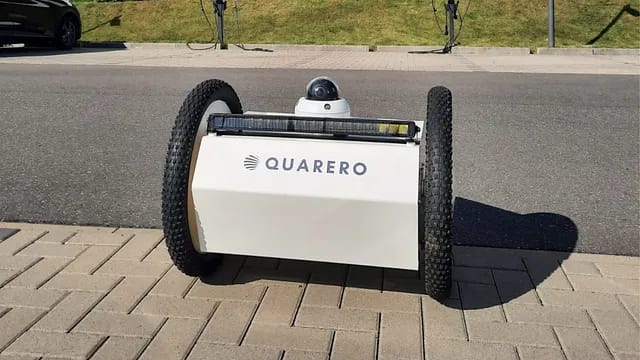Border areas often span thousands of kilometers and cover diverse terrains such as deserts, mountains, and rivers. Traditional surveillance methods—stationary cameras and human patrols—quickly reach their limits in such environments. Limited lines of sight, rough terrain, and the need for round-the-clock monitoring make effective control a constant challenge.
Additionally, border security agencies face a wide range of threats, including illegal border crossings, smuggling of goods and drugs, and potential terrorist activities. Rapid incident response requires flexible and reliable surveillance solutions.
The Quarero Stingray: A Breakthrough Solution
The Quarero Stingray was developed to meet the specific demands of border surveillance. As an autonomous mobile robot, it combines advanced sensors, artificial intelligence, and durable mechanics to operate efficiently in harsh environments.
Key Features of the Quarero Stingray:
-
Autonomous Navigation: With GPS and LIDAR technology, the Stingray follows pre-defined patrol routes, detects obstacles, and navigates around them.
-
Multi-Sensor Capability: Equipped with high-resolution cameras, thermal imaging, and acoustic sensors, it detects people and activities even in low-visibility conditions.
-
Real-Time Data Transmission: All data collected is instantly transmitted to control centers, allowing rapid responses to incidents.
-
All-Terrain and All-Weather Design: Built to withstand extreme weather and rough terrain.
Use Cases in Border Security
-
Patrolling Remote Areas: In inaccessible border regions, the Stingray can autonomously patrol and gather data continuously without needing on-site personnel.
-
Detecting Illegal Activities: Integrated AI algorithms can recognize suspicious patterns—such as repeated movement or strange sounds—and issue alerts.
-
Emergency Support: In cases where people in distress are detected (e.g., injured migrants), the Stingray can transmit precise location data and guide medical responders.
Advantages Over Traditional Methods
-
Reduced Risk to Personnel: The Stingray minimizes the need to send humans into dangerous or hard-to-reach areas.
-
Cost Efficiency: Over time, autonomous patrols lower operational costs by reducing manpower needs.
-
Scalability: Multiple Stingray units can work together to monitor large sections of border effectively.
-
Data Analysis: Collected data supports detailed analysis of movement patterns and potential security gaps.
Integration with Existing Systems
The Quarero Stingray can be seamlessly integrated into current security infrastructures. Open interfaces allow it to communicate and exchange data with drones and stationary cameras, enabling unified surveillance and fast incident response.
Looking Ahead
As technology evolves, future versions of the Stingray could include features such as chemical or biological detection, or collaborative swarm operation with other robots. These advancements will further strengthen the capabilities of modern border security.
Conclusion
Integrating robotics into border security—exemplified by the Quarero Stingray—offers a compelling response to today’s border surveillance challenges. Combining autonomy, cutting-edge sensors, and real-time data processing, the Stingray complements existing systems and represents a major step toward smarter, more effective security operations.
📩 Email: info@quarerorobotics.com
🌐 Web: www.quarerorobotics.com
The post Robots in Border Security first appeared on Presslink Media.

